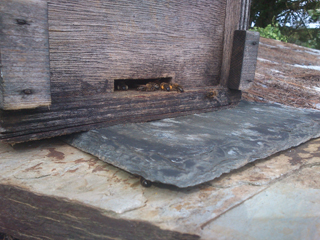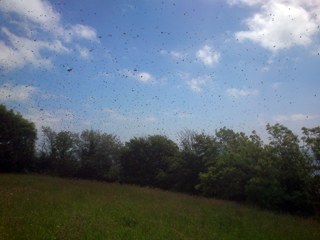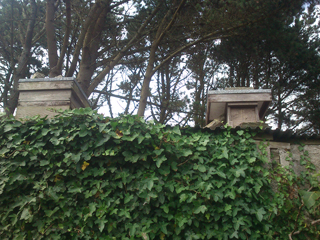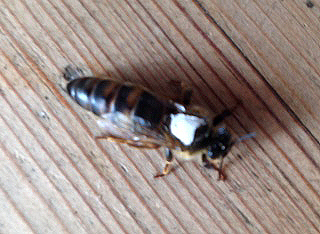 My worst fears have been realised – I think we are unlikely to get a honey crop this year! It started about 6 weeks ago with a warning email from the National Bee Unit saying to be aware that colonies were likely to be nearing starvation point and for us to check our hives. I duly did what was asked and found that all my established colonies were still alright for stores but the nuclei I had raised and the swarms I had collected were indeed without any reserves whatsoever. I therefore set to and fed those in need.
My worst fears have been realised – I think we are unlikely to get a honey crop this year! It started about 6 weeks ago with a warning email from the National Bee Unit saying to be aware that colonies were likely to be nearing starvation point and for us to check our hives. I duly did what was asked and found that all my established colonies were still alright for stores but the nuclei I had raised and the swarms I had collected were indeed without any reserves whatsoever. I therefore set to and fed those in need.
The reason for this onset of starvation was the fact that colonies had been growing ever bigger during the Spring and had used up most of their spring crop of nectar and pollen in feeding their growing number of young and themselves. We then hit what beekeepers refer to as the “June gap”, a period after the Spring flow of early flowers and trees when there is very little in the way of food in the fields and our gardens to sustain the bees.
 What has happened since then is that once the nectar started flowing again, it was all put (and is still being put) into the brood box, or nest area, of the hive, with very little, if any, surplus being available to place in the supers. This is exacerbated by the fact that the colonies are now at their largest for the season, with many more mouths to feed than at any other time in the year, So whilst I have live bees (which is really the object of the exercise), I have no surplus honey to remove for sale. Disappointing, but an occurrence that is seen from time to time and one we must accept.
What has happened since then is that once the nectar started flowing again, it was all put (and is still being put) into the brood box, or nest area, of the hive, with very little, if any, surplus being available to place in the supers. This is exacerbated by the fact that the colonies are now at their largest for the season, with many more mouths to feed than at any other time in the year, So whilst I have live bees (which is really the object of the exercise), I have no surplus honey to remove for sale. Disappointing, but an occurrence that is seen from time to time and one we must accept.
On the positive side, I have a greater number of colonies and therefore bees than I did at the start of the season, so that augurs well for the environment. The nuclei I raised have been passed on to new beekeepers and were very strong, which again is a good sign from the point of view of their developing sufficiently to see them through the winter. In fact, one of them was so strong that three days after it had been moved to the new owner’s site, it swarmed! How embarrassing for me is that?!
 I didn’t think for a moment that it was actually that far developed so didn’t check for swarming preparations, as I do my standard production colonies. So somewhere in the Rosevine area there is a swarm which has, presumably, by now found a new home. If you know of such a situation, please let me know so that the swarm can be reunited with its parent colony and our new beekeeper doesn’t have to wait until the Spring to start beekeeping proper.
I didn’t think for a moment that it was actually that far developed so didn’t check for swarming preparations, as I do my standard production colonies. So somewhere in the Rosevine area there is a swarm which has, presumably, by now found a new home. If you know of such a situation, please let me know so that the swarm can be reunited with its parent colony and our new beekeeper doesn’t have to wait until the Spring to start beekeeping proper.
When one of the other nucs I had created had proven its credentials (a nice, circular brood pattern with stores above and below), I transferred it to the nuc box provided by the new beekeeper and brought it home from my out-apiary. The next day was the first really hot day we had, about 3 weeks ago, but I didn’t pay much attention to that fact. Until, when I was doing my normal walk-about in the apiary at lunch-time, I spotted what looked like the tail-end of a swarm disappearing over the hedge into the field next door.
 Also, there was a golf-ball sized cluster of bees on a blackthorn branch just under where I saw the cloud of bees. I went around to the other side of the hedge but found nothing – I was expecting to find a classic “bunch of grapes” swarm hanging from a branch – but by then even the golf ball had gone. “Ah well, I wonder where they came from” was my initial thought, as I wasn’t expecting any of my colonies to swarm at this point.
Also, there was a golf-ball sized cluster of bees on a blackthorn branch just under where I saw the cloud of bees. I went around to the other side of the hedge but found nothing – I was expecting to find a classic “bunch of grapes” swarm hanging from a branch – but by then even the golf ball had gone. “Ah well, I wonder where they came from” was my initial thought, as I wasn’t expecting any of my colonies to swarm at this point.
That evening, when I went to check the nucs that I had brought home, I found one of them virtually devoid of bees! They had absconded, presumably because of the heat and the poor insulating properties of this particular nuc box. I now realised that was what I had seen earlier in the day disappearing over the hedge. So I then had to set to to find another nuc for this particular beekeeper – I couldn’t just tell him “Your bees have absconded – hard luck”!
 Then, three days later, whilst I was helping another beekeeper by loaning him some equipment to retrieve a swarm that had gone into a cavity wall, his wife noticed there was a small number of bees flying round in a cloud, just like a miniature swarm. I had no idea where they had come from so we carried on with what we were doing. After lunch, I went back to the apiary and found a small cluster of bees hanging in a tree.
Then, three days later, whilst I was helping another beekeeper by loaning him some equipment to retrieve a swarm that had gone into a cavity wall, his wife noticed there was a small number of bees flying round in a cloud, just like a miniature swarm. I had no idea where they had come from so we carried on with what we were doing. After lunch, I went back to the apiary and found a small cluster of bees hanging in a tree.
I collected it in my swarm box, the bees started fanning, so I thought all was well. I therefore left them, as is the practice, to hive later in the day. That evening, when I checked the swarm box, it was empty! The bees had gone – but there was now another small cloud of bees flying around the apiary, settling on a blackthorn bush – the bees I had put in my swarm box, presumably!
 This time, once the bees had settled, I carefully cut off the branch that they were on and slowly lowered it into an empty poly nuc box and covered the entrance with a queen excluder – if it was those earlier recalcitrant bees, I was not having them decamp yet again! When I checked them a couple of days later, after they had settled in to their new home, I found a marked queen – the very one that had absconded from the earlier nuc box through over-heating! They must have been hanging around in the field somewhere and then decided life in my apiary was not so bad after all and come back! They are now settled and are building up again – but what a palaver! Who’d be a beekeeper?!
This time, once the bees had settled, I carefully cut off the branch that they were on and slowly lowered it into an empty poly nuc box and covered the entrance with a queen excluder – if it was those earlier recalcitrant bees, I was not having them decamp yet again! When I checked them a couple of days later, after they had settled in to their new home, I found a marked queen – the very one that had absconded from the earlier nuc box through over-heating! They must have been hanging around in the field somewhere and then decided life in my apiary was not so bad after all and come back! They are now settled and are building up again – but what a palaver! Who’d be a beekeeper?!
Finally, to prove I don’t just have swarms and nucs to soak up my time, I have just collected the sample trays from under two of my colonies at home to send off for the half-yearly analysis by the National Bee Unit, who are looking for Varroa and other exotic pests. I look forward to seeing the results and will let you know next month why and what they find.
Colin Rees – 01872 501313 – colinbeeman@aol.com

